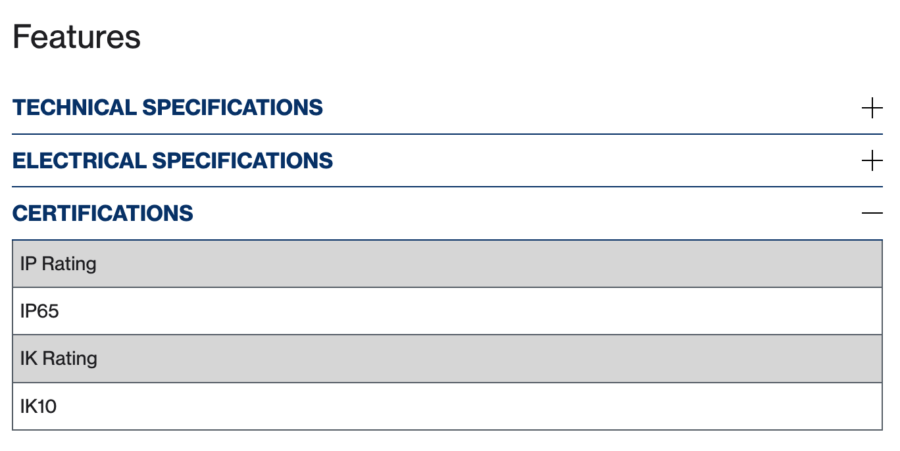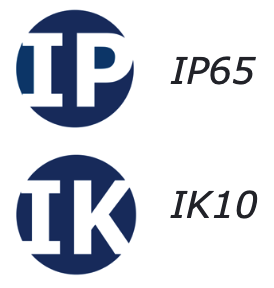Electrical products often come with an IP rating and/or an IK rating. In a nutshell, these numbers indicate how well the product is protected from damage by ingress or impact. The higher the rating, the better the product performed in testing. If an electrical product is going to be installed outdoors, it needs a higher level of protection to help it keep operating even when exposed to the elements.
What is the difference between IP and IK ratings?
IP stands for Ingress Protection. This is a rating of how well the product can resist liquids and solids from getting into its internal components. On the other hand, IK ratings are all about impact. The K stands for ‘kinetic’, in order to distinguish it from IP ratings. This is a measure of how well the product can withstand mechanical impact. In other words, how hard can you hit it before it breaks?
What are IP ratings?
What is ingress?
Ingress means ‘entry’. In relation to IP and IK ratings, ingress refers to liquids and solids getting inside the electrical product and potentially causing damage or failure. Liquids (most commonly rain water) getting inside an electrical product can cause electrical shortages and render it dangerous. Solids such as dust or sand that might be blown around in the wind could also interfere with circuit boards and electrical components.
What do the IP rating numbers mean?
An IP rating consists of a two-digit number. The first digit is measured on a scale from 0-6 and indicates protection against liquid ingress. The second digit measures resistance to solid ingress and is measured on a scale from 0-8. In both cases, a 0 rating means the product has no protection at all against liquids or solids from getting inside.
The lowest possible IP rating is therefore IP00. The highest possible rating is IP68. A product that is rated IP68 is impenetrable by dust and can withstand full immersion in water for long periods of time.
What IP rating is needed for products to be installed outdoors?
The choice to place a product in an outdoor setting is always up to the installer. It is their responsibility to analyse the environment for risks and suitability and recommend the right products.
With regards to IP ratings, the installer should consider how exposed the product will be to the effects of weather. For example, a keypad inside a covered kiosk will be at less risk of rain ingress than one at an outdoor car park entrance.
For the second digit of the IP rating, which focuses on liquid ingress, testing is done with jetted water. Ratings 7 and 8 refer only to the product’s ability to withstand immersion in water. A rating of IPX6 means the product resists a 12.5mm jet delivering 100 litres of water per minute for at least three minutes. That’s a lot more water at a much higher pressure than any naturally occurring rain in the UK.
What are IK ratings?
Why are IK ratings important?
IK ratings measure resistance to mechanical impact. This is an important factor if a product is to be installed in an area of high traffic or somewhere that is prone to vandalism. There are risks of mechanical damage everywhere. It could be something minor like a busy member of staff carrying a box accidentally knocking a product. Or, in serious cases, it could be malicious vandalism.
Damaged electrical products may stop working properly or fail entirely. In both cases, there would be additional costs for replacing or repairing the item. At the same time, an access system that isn’t working is hugely inconvenient for users, as well as a serious risk to security.
How are IK ratings measured?
The tests for IK ratings consist of hitting the product with different weights from different distances. Mechanical impact is measured in joules of energy. The scale runs from IK00 to IK10.
A rating of IK00 (the lowest possible rating) means the product has no protection at all against any mechanical impact. The highest possible rating is IK10, which means the product is protected against 20 joules of impact. That is the equivalent of dropping a 5kg weight from 400mm above the product’s surface.
Find out more about IP and IK ratings
IP and IK ratings are designed to help installers compare different products using the same criteria. It helps them to assess the suitability of a product for a particular project using neutral third-party measures.
For more information about these two criteria, check out our detailed guide.
When browsing CDVI products, look out for IP and IK ratings. On our website pages, you’ll find them under the Certifications section of the Features table.

On our datasheets, you’ll see round icons on the first page, in the bottom-right.

